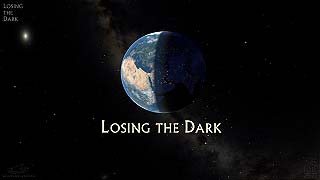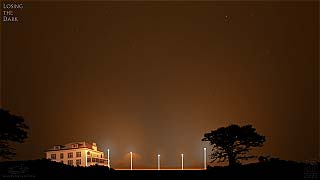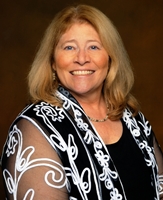Report
by Carolyn Collins Petersen
If you were going to make a video about light pollution and its effects on people, and it could only be five or six minutes long, what would you tell people? There are so many aspects to the issue of light pollution that it's very tough to pick out just a few facts to impress on viewers. That was the challenge a group of us faced as we set out to create our newly released 6.5-minute video called "Losing the Dark."
 A frame from the title sequence of Losing the Dark. CREDIT: Loch Ness Productions.
A frame from the title sequence of Losing the Dark. CREDIT: Loch Ness Productions.
The project was inspired by a conversation between Dr. Connie Walker and a planetarium person in Portugal. That led to a meeting between my company Loch Ness Productions and the Education Committee of the International Dark-Sky Association, headed by Dr. Walker. The group wanted to do a planetarium show for fulldome video and after much discussion, we also decided to create a flat-screen HD version of the same show for use in planetariums without digital video, for teachers in classrooms, and for outreach professionals and dark-sky advocates who needed something to show their audiences.
The committee wanted to show the effects of light pollution on the wilderness as well as in urban locales. The impact on wildlife is also important, and we also needed to communicate to people that light pollution wastes money and energy. These are all serious issues, and we didn't want to browbeat people. So, we planned to have the show end on an "upbeat" note, reminding people that there are actually some simple ways to mitigate the effects of lights at night in their communities and neighborhoods. Above all, we wanted to find a way to touch people's hearts with a message about light pollution. I set out to think of a tag line that would summarize the show, and hit on one early in the process: "We are losing the dark of night at the speed of light." It became our guiding principle throughout the production of the show.
 A still frame from Losing the Dark showing the glow of traffic and city lights in Chicago.
A still frame from Losing the Dark showing the glow of traffic and city lights in Chicago.
This timelapse sequence was shot by Matt Mascheri, Dome3D. CREDIT: Loch Ness Productions/Dome3D.
By late summer 2012 we had a "final" script, which gave us (the producers) a direction to go in finding visualizations. We finally settled on a mix of video material showing a timelapse sunset in Colorado, light-polluted skies over Phoenix, Arizona, a night-time timelapse sequence shot at Gemini Observatory on Mauna Kea, Hawai'i, timelapse sequences of Chicago city lights from an award-winning fulldome video called Second City produced by our friends at Dome3D, and several breathtaking images from astrophotographers, including Babak Tafreshi of The World at Night. Some especially stunning footage shot from the International Space Station also appears, making the point that we are lighting UP the sky and it's easily visible from space. Coupled with some animated graphics showing how light pollution can be mitigated using proper light, the visual plan for the show was complete.
Once the script was approved and a rough "animatic" put together, we had a "sneak preview" version we could show at the International Astronomical Union meeting in Beijing, China. The staff at the planetarium there were extremely helpful, and successfully showed the presentation to a packed house.
 A still frame from Losing the Dark illustrating the effect that unshielded lights have on
A still frame from Losing the Dark illustrating the effect that unshielded lights have on
the sky. Art based on the Light Pollution Simulator at the Need-Less Campaign
by Don Nixon. CREDIT: Loch Ness Productions.
 A still frame from Losing the Dark illustrating the effect that using fully shielded lights
A still frame from Losing the Dark illustrating the effect that using fully shielded lights
can have on the sky. Art based on the Light Pollution Simulator at the Need-Less
Campaign by Don Nixon. CREDIT: Loch Ness Productions.
We got a tremendous amount of good feedback from that showing, plus a showing we did at the Astronomical Society of the Pacific meeting in Tucson, and used it to tweak the final production, which commenced in late 2012. The narration and soundtrack were finalized early in 2013, and the final video was released on February 27, 2013. The video is actually in two versions. The original fulldome version for digital planetarium theaters is available on the Loch Ness Productions Losing the Dark page; the flatscreen version is also there for the use of classic planetarium theaters that are not equipped with fulldome systems. The flatscreen HD version also is available at the IDA's Losing the Dark web page for educators, advocates, outreach professionals to download. There's also a YouTube link for people who can stream the show live.
The best news of all is that the show is free for download! The production costs for the show were paid for by generous support from the creators of Starmap (a mobile planetarium app for iPhone and iPad), the Fred Maytag Family Foundation, a seed grant from the International Planetarium Society, and donations from individual IDA members.
Thanks to Dark Skies Awareness Blog for inviting me to do a guest blog about this project. We hope it helps bring about even more awareness among members of the public about the encroachment of lights on our lives.
###
 Carolyn Collins Petersen is CEO of Loch Ness Productions, and writer, narrator, and co-producer of the IDA short documentary called "Losing the Dark". On the Web, Carolyn is proprietor of "TheSpacewriter", a popular website that contains the Henrietta Leavitt Flat Screen Space Theater — the Web's first online planetarium show, and The Spacewriter's Ramblings, a blog about astronomy, science, and related subjects. She can be reached at [email protected]
Carolyn Collins Petersen is CEO of Loch Ness Productions, and writer, narrator, and co-producer of the IDA short documentary called "Losing the Dark". On the Web, Carolyn is proprietor of "TheSpacewriter", a popular website that contains the Henrietta Leavitt Flat Screen Space Theater — the Web's first online planetarium show, and The Spacewriter's Ramblings, a blog about astronomy, science, and related subjects. She can be reached at [email protected]








Comments